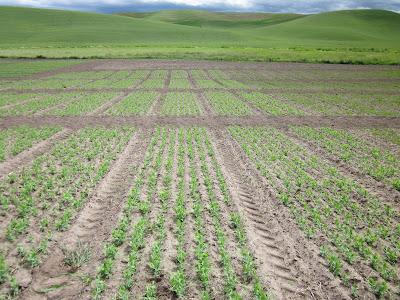So are you like me, a corn and soybean guy that didn't know how much work it takes to grow apples? Well I imagine that after they are up and producing, you can just put your feet up and wait for harvest. Well there is probably more to it than that. But in the new orchard on Farm 8, now with the posts and wires in, it is time to start training the branches. I talked a little about this from my trip to Washington this week. The idea is to get the branches to grow sideways, parellel to the wire, and not out into the row middles. Plus you want lateral growth, not straight up growth. So like kids, you have to start training them early while they are still pliable. Below we see Intern Kirk using big rubber bands to bend the little branches down.
Here is a close-up. Also notice the wire around the tree that would hold it to the wire and not flap around. They did this prior to rubber banding. Recall that there are over 3000 trees here.
Below we see Dan applying rubber bands to the trees in the border row. There is no wire here. These are for replacements in case a tree dies out in the main part. Pray for no tree mortality. (By the way, all of those weeds in the row have been recently sprayed.)
So you can barely see Kirk back up the row. They will be at this for awhile. (I had important fertilizer issues to deal with, so I was unable to provide assistance. Plus they would have had to re-do it all anyway.) So did I say we have been very dry at the NCRS? We did get nearly 4/10" on Monday, but could sure use more. Doesn't it look like the sky is about to open up here last Thursday? Well you know how it is when about 5 big drops fall, and that's it? That was it here.
Meanwhile on Friday, the long process of soybean foliars started with applications to V4 soybeans, here on Farm 3. Here Tim makes applications in the Hagie on Friday. (Photo credit to Stephanie.) Now that we are into summer with the days now becoming shorter, this will trigger flowering soon in these soybeans.
Well that was a week. Other than the dryness, things are going pretty well here at the NCRS. I sure hope you are planning to attend one of our six Research Field Days coming up in August.

































